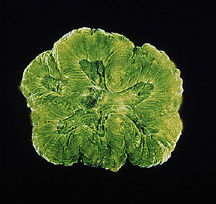
Pillar coral is a hard coral found in the western Atlantic Ocean and the Caribbean Sea. It is the only species in the monotypic genus Dendrogyra. It is a digitate coral -that is, it resembles fingers or a cluster of cigars, growing up from the sea floor without any secondary branching. It is large and can grow on both flat and sloping surfaces at depths down to 20 m (65 ft). It is one of the few types of hard coral in which the polyps can commonly be seen feeding during the day.

Porites astreoides, commonly known as mustard hill coral or yellow porites, is a colonial species of stony coral in the family Poritidae.

Plerogyra sinuosa is a jelly-like species of the phylum Cnidaria. It is commonly called "bubble coral" due to its bubbly appearance. The "bubbles" are grape-sized which increase their surface area according to the amount of light available: they are larger during the day, but smaller during the night, when tentacles reach out to capture food. This species requires low light and a gentle water flow. Common names for Plerogyra sinuosa include "grape coral", bladder coral, and pearl coral. According to the IUCN, Plerogyra Sinuosa ranges from the Red Sea and Madagascar in the eastern Indian Ocean to Okinawa and the Line Islands in the Pacific.

Eusmilia is a genus of stony coral in the family Meandrinidae. It is a monotypic genus represented by the species Eusmilia fastigiata, commonly known as the smooth flower coral. It is found on reefs in the Caribbean Sea.

Siderastrea radians, also known as the lesser starlet coral or the shallow-water starlet coral, is a stony coral in the family Siderastreidae. It is found in shallow parts of the western Atlantic Ocean as small, solid mounds or encrusting sheets.
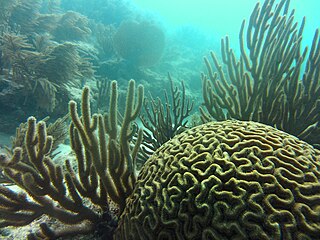
Pseudodiploria strigosa, the symmetrical brain coral, is a colonial species of stony coral in the family Mussidae. It occurs on reefs in shallow water in the West Atlantic Ocean and Caribbean Sea. It grows slowly and lives to a great age.
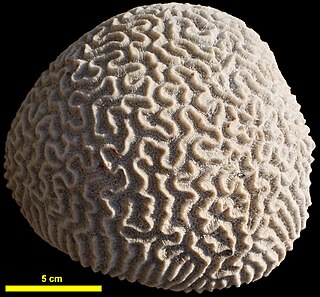
Pseudodiploria clivosa, the knobby brain coral, is a colonial species of stony coral in the family Mussidae. It occurs in shallow water in the West Atlantic Ocean and Caribbean Sea.

Dichocoenia is a monotypic genus of stony coral in the family Meandrinidae. It is represented by a single species, Dichocoenia stokesii, which is commonly known as pineapple coral, elliptical star coral, or pancake star coral. It is found in the Caribbean Sea and the western Atlantic Ocean. Dichocoenia stokesii has irregular calyces and its form can be either a massive, hemispherical hump or a flat, platform-like structure.

Lobophyllia corymbosa, also known as lobed cactus coral or brain root coral, is a species of large polyp stony coral in the family Lobophylliidae. It occurs on reefs in shallow waters in the Red Sea, off the coast of East Africa, and in other parts of the tropical Indo-Pacific.
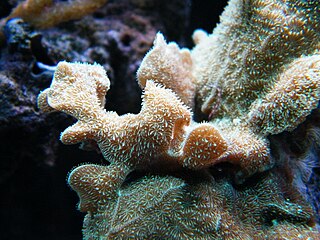
Pavona cactus, the cactus coral, potato chip coral or leaf coral, is a species of colonial stony coral in the family Agariciidae. This coral is found in shallow waters on reefs and in lagoons in tropical parts of the Indo-Pacific region.
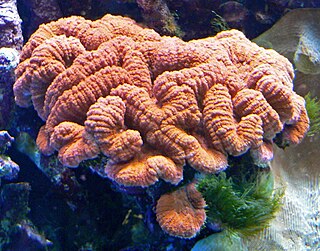
Lobophyllia hemprichii, commonly called lobed brain coral, lobed cactus coral or largebrain root coral, is a species of large polyp stony coral in the family Lobophylliidae. It is found in the Indo-Pacific Ocean. In its specific name Christian Gottfried Ehrenberg honoured his late partner the Prussian naturalist Wilhelm Hemprich; they were among the first to study the marine life of the Red Sea.

Acropora loripes is a species of branching colonial stony coral. It is common on reefs, upper reef slopes and reef flats in the tropical Indo-Pacific. Its type locality is the Great Barrier Reef.
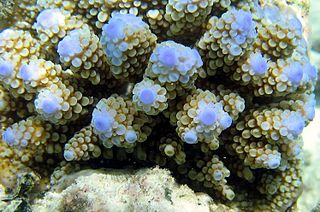
Acropora nasuta is a species of branching stony coral in the family Acroporidae. It is native to the western and central Indo-Pacific where it is found in shallow reef habitats. Like other corals of the genus Acropora, it is susceptible to coral bleaching and coral diseases and the IUCN has listed it as being "Near Threatened".

Turbinaria peltata, commonly known as disc coral, is a species of colonial stony coral in the family Dendrophylliidae. It is native to the Indo-Pacific region. The International Union for Conservation of Nature has rated its conservation status as being "vulnerable".

Favites pentagona is a species of stony coral in the family Merulinidae, sometimes known as larger star coral. It is native to the Indo-Pacific region and its range extends from the Red Sea through the Indian Ocean to the Western Pacific Ocean. This is a common species throughout its wide range and the International Union for Conservation of Nature has rated its conservation status as being of "least concern".
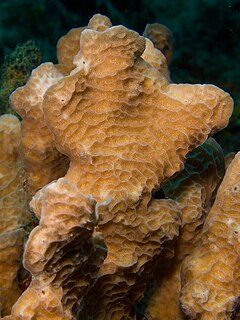
Agaricia agaricites, commonly known as lettuce coral or tan lettuce-leaf coral, is a species of colonial stony corals in the family Agariciidae. This coral is found in shallow waters in the tropical western Atlantic Ocean and the Caribbean Sea. It is a common species and the IUCN has assessed its status as being of "least concern".

Agaricia tenuifolia, commonly known as thin leaf lettuce coral, is a species of colonial stony coral in the family Agariciidae. This coral is found in shallow waters in the Caribbean Sea and Gulf of Mexico.

Oulophyllia crispa, sometimes called the intermediate valley coral, is a species of stony coral in the family Merulinidae. It is native to the tropical western and central Indo-Pacific region. Although this coral has a wide range, it is generally uncommon and seems to be decreasing in abundance, and the International Union for Conservation of Nature has rated its conservation status as being "near threatened".

Manicina areolata, commonly known as rose coral, is a colonial species of stony coral. It occurs in shallow water in the West Atlantic Ocean and Caribbean Sea, sometimes as small solid heads and sometimes as unattached cone-shaped forms.
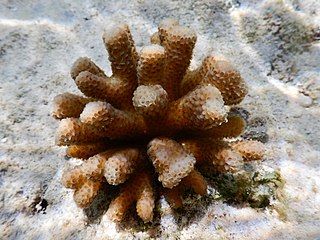
Stylophora madagascarensis is a species of stony coral in the family Pocilloporidae. It is native to the tropical western Indian Ocean where it is confined to the coasts of Madagascar, growing in shallow water.
